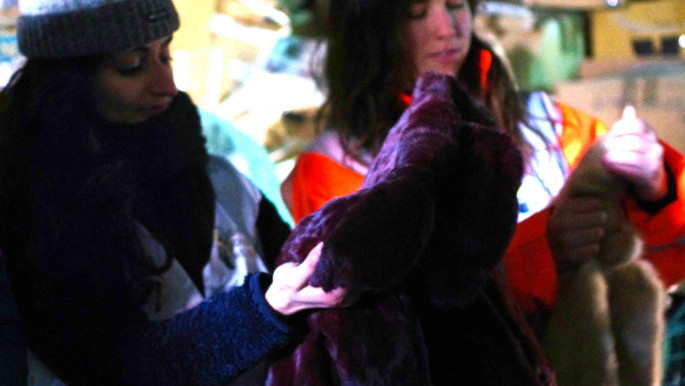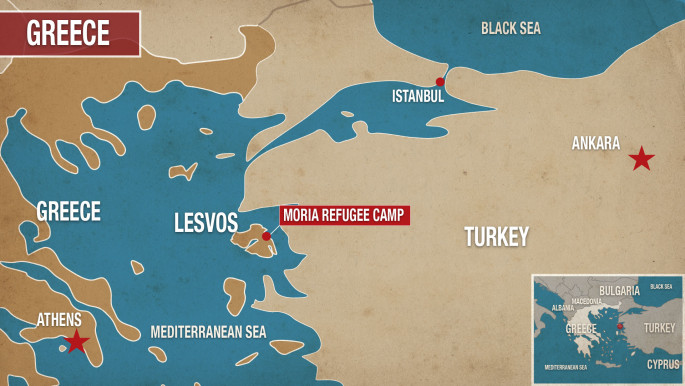
Why PETA is using old fur coats to save lives in Lesvos
The garments - sent to us by members of the British public who'd had a change of heart about wearing the cruelly produced items - were given to refugees facing freezing winter conditions in camps on Lesvos, Greece.
Last year, PETA offered a fur coat to every homeless person in Iceland. We know we can't bring back the minks, rabbits, dogs, and other animals whose fur was torn off to make these items, or take back the suffering they endured, but we can help prevent further deaths by offering warmth to refugees and others at risk in the bitter cold while also encouraging compassionate people around the world to rid their wardrobes of fur.
Before the coats were sent to Lighthouse Relief - a charity working to provide refugees with vital assistance - and distributed locally on Lesvos, each was marked to show its charitable status.
This sends a clear message to the fur industry, which still desperately tries to portray its products as glamorous status symbols: People would now rather give away their fur coats to those in need, than wear them.
Decades ago, people could claim ignorance about animal suffering in the fur industry, but today that's impossible.
 |
As more and more people turn their backs on fur, it's common for unwanted fur coats to be left at the backs of wardrobes or sent to landfill |  |
Anyone with an internet connection is likely to have seen videos and photos of animals on fur farms, who spend their lives confined to tiny, wire cages, often with little to no protection from the snow and sleet in wintertime or the scorching summer sun.
In their natural habitat, foxes live in small family groups, and Arctic foxes are known to wander hundreds of miles from their place of birth.
 |
|
| The charity Lighthouse Relief receives donations of fur coats in Lesvos [PETA] |
Minks are naturally shy animals who avoid human contact, yet fur farm cages force them into close proximity with humans as well as hundreds of other animals, often leading to fights which result in injuries, blindness, and open, infected bite wounds that almost always go untreated.
The stress and deprivation caused by confinement commonly drive animals insane, so they engage in self-mutilation and unnatural repetitive behaviour, such as endless circling. These frightened, distressed animals then endure a violent death by electrocution, neck-breaking, drowning, gassing or strangulation.
In China, the world's largest exporter of fur, 2 million cats and dogs are skinned every year, sometimes while they're still alive, and their fur is sold around the globe.
In North America, coyotes are caught in bone-crushing steel traps. Those not killed outright by these devices may be shot at close range by trappers or languish for days before eventually dying of starvation, thirst or blood loss.
Nursing mothers have even been known to chew through their own limbs in their desperate attempts to return to their babies.
These tormented animals' fur is used as nothing more than pieces of trim on the hoods of Canada Goose coats.
Fur production is not only hell for animals but also an ecological nightmare. Government agencies around the world have identified it as a major polluter. The chemicals used to keep pelts from decomposing in people's wardrobes are highly toxic and poison rivers and streams, killing fish and other aquatic life.
Given these realities, you'd be forgiven for questioning whether we live in a civilised society.
But protests across every continent, PETA's work behind the scenes with retailers, celebrity-fronted campaigns, and expose after expose are having a huge impact.
Fur farming has already been banned in Austria, Bulgaria, Croatia, Israel, and the UK because of public opposition. Just in the last few months, leading international designers from Gucci to Michael Kors have committed to a fur-free future, joining the likes of Stella McCartney, Vivienne Westwood, Calvin Klein, and Ralph Lauren.
 |
|
| [Click to enlarge] |
With the number of humane, cutting-edge fabrics now available, anyone wanting the look and feel of real fur can choose from a plethora of vegan options in both high-street and high-end shops.
As more and more people turn their backs on fur, it's common for unwanted fur coats to be left at the backs of wardrobes or sent to landfill - which is why PETA's fur-donation programme was set up.
Last winter, at least three people died in freezing temperatures in the Moria refugee camp on Lesvos, and according to reports, the conditions haven't improved this year.
"I can't guarantee people won't die from the cold," said Ioannis Mouzalas, the Greek alternate minister of immigration policy.
Refugees are reportedly facing the rain and cold with little more than flimsy tents, thin plastic capes, and flip-flop sandals. By all accounts, the infrastructure designed to cope with refugees is being pushed to breaking point, and warmth from a fur coat can help alleviate at least some of this suffering.
We can't right the wrongs done to the animals killed to make these garments, but we can ensure that some good comes from the horror they endured.
We encourage anyone who still has a tired old fur garment tucked away from a time when we were less aware of the cruelty that went into every stitch, to consider sending it to us so that it can be put to good use in similar donation programmes.
The fur industry is a dirty, ugly business. Let's choose kindness instead.
Mimi Bekhechi is director of international programmes at People for the Ethical Treatment of Animals (PETA), the UK's largest animal rights organisation.
Follow PETA on Twitter: @PETAUK
Opinions expressed in this article remain those of the author, and do not necessarily represent those of The New Arab, its editorial board or staff.





 Follow the Middle East's top stories in English at The New Arab on Google News
Follow the Middle East's top stories in English at The New Arab on Google News


